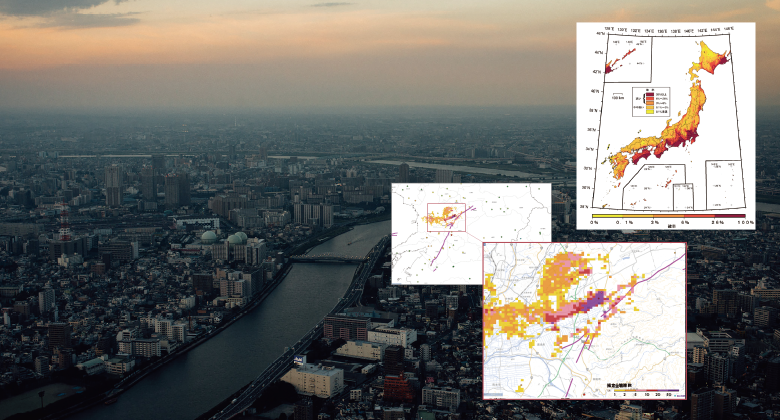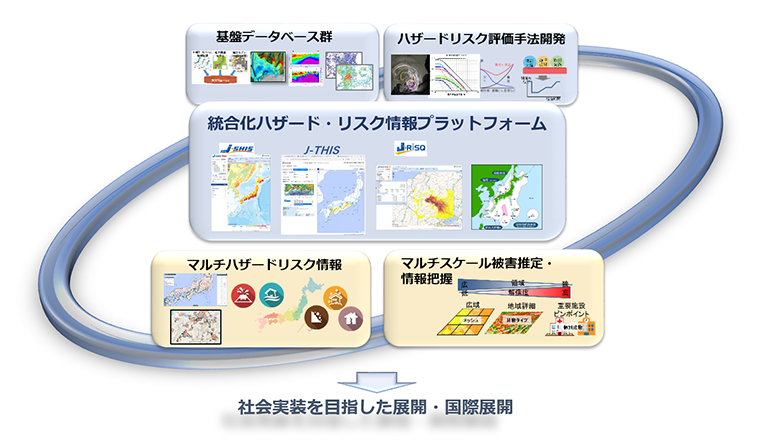Research and development regarding hazard and risk assessment
Prediction and preparedness for future disasters

In order to sustainably increase the resilience of society as a whole and reduce disaster risk, each entity that makes up society, including the national government, municipalities, corporations, communities, and individuals, must properly identify and prepare for risks. In this project, we will engage in comprehensive research on hazard and risk assessment for natural hazards based on scientific knowledge using data on the natural and social environment, with the aim of realizing a society that can make appropriate decision-making in the event of a disaster. Here, a hazard refers to the risk of being hit by potentially threatening phenomena such as seismic motions and tsunamis, and a risk refers to the susceptibility of a society to damage due to exposure to hazards.

Research on hazard risk assessment for earthquakes and tsunamis
We will develop hazard and risk assessment methods taking into account the uncertainty of large-scale disasters that have never been experienced before, and we will prepare fundamental information on earthquake and tsunami hazards. In addition, we will develop risk assessment methods for complex disasters (e.g., sediment disasters, liquefaction, etc.) that accompany earthquakes. We will also build databases of strong motion observation records, underground structures, active faults, etc., and develop simulation technologies necessary for these research and development activities. We will develop a hazard and risk information platform to disseminate the results of our research and development both within and outside the institute and facilitate their use. We will also compile information based on the results of our research and development that will be useful for disaster management measures by the MEXT's Headquarters for Earthquake Research Promotion and other disaster management administration, as well as for disaster management measures by communities and companies.
Research on multi-hazard risk assessment
We are working on the development of a multi-hazard risk assessment method that takes into account regional characteristics and diversity of occurrences, by utilizing various simulation technologies based on a multi-hazard event catalog that has been compiled into a database of disaster cases from the historical period to the present day throughout Japan, including not only earthquakes and tsunamis but also other natural hazards, as well as landslide topographic distribution maps. In addition, we will develop a method for predicting damage that gives an overview of the whole situation, a method for evaluating economic damage based on this, and a quantitative evaluation method for resilience that can evaluate the maintenance and recovery of the overall function of society, as well as fundamental data on the social environment, such as buildings and population, that is necessary for assessment.
Research on real-time damage estimation and situation awareness
Based on the needs of municipalities, companies, and other entities to use a real-time earthquake damage estimation system for the whole country immediately after an earthquake as a fundamental system to aid in their decision-making in disaster response, we will work on developing a system that utilizes sensing technology from aircraft and drones to improve the spatial resolution of damage estimation and enable damage estimation from a wide area down to the individual building level of important facilities, etc., in collaboration with other systems.
International dissemination of research results
For the international dissemination of R&D results, we will promote international research exchange and sharing and mutual understanding of data, including observation records, and models related to hazard and risk assessment. Through our activities with the Global Earthquake Model (GEM), an international NPO, we will work towards the standardization of international hazard and risk assessment models, and we will contribute to disaster risk reduction and mitigation in Japan and the international community based on the goals of the Sendai Framework for Disaster Risk Reduction 2015-2030.
